|
Argumentation
"A careful thin section analyses of the
laminated limestone revealed a diverse late Maastrichtian
planktic foraminiferal assemblage and few low oxygen
tolerant benthic foraminifera (mostly buliminellids).
The species are invariably recrystallized and poorly
preserved, as would be expected in micritic limestones.
But, the recrystallization process generally retained
the original species morphology, and lighter colored
chamber infillings make them clearly recognizable with
respect to the surrounding micrite."
"The first diverse and abundant planktic foraminiferal
assemblage is present 5 cm above the impact breccia
(sample 20, 794.55–794.56 m) and includes species of
Globotruncana (G. stuarti, G. insignis), Rosita contusa,
Abathomphalus mayaroensis, Rugoglobigerina (R.
rugosa, R. macrocephala), Plummerita hantkeninoides,
Globotruncanella petaloidea, Heterohelix, Hedbergella,
and Globigerinelloides. Most of these species can
also be identified in the other laminated intervals,
including sample 9 (794.13–794.14 m) at 2 cm below the
green clay that marks the K/T boundary but not above
it. Planktic foraminiferal assemblages are, thus, of
high diversity with large and small, fragile and robust
species present, and all are characteristic of the late
Maastrichtian. Such uniform assemblages cannot be explained
by backwash and crater infill, but they are consistent
with in situ deposition in a normal low energy marine
environment."
"The age of this late Maastrichtian assemblage can be
further narrowed based on the presence of the biozone
CF1 marker Plummerita hantkeninoides, which spans
the last 300 kyr of the Cretaceous. This is consistent
with the magnetostratigraphic results at Yax-1 and indicates
that the laminated limestone and glauconite layers between
the breccia and K/T were deposited sometime during the
last 300 kyr of the Maastrichtian. The K/T boundary
is marked by a 2-3 cm-thick dark gray-green marly limestone
with a 3 to 4 mm-thick green glauconite clay that marks
an erosional disconformity. Most Cretaceous planktic
foraminifera disappear at this interval. Only very rare
early Danian foraminifera are preserved in the green
clay (as a result of downward reworking) that marks
the K/T hiatus."
"The most significant evidence of deposition in lowenergy
environments is revealed by five green clayey glauconite
layers embedded within the laminated limestone at 794.43,
794.34–794.35, 794.24, 794.19, and 794.11 m, with the
latter at the K/T boundary. The microclasts of these
layers are of glauconite origin and/or have in situ
glauconite coating, as revealed by environmental scanning
electron microscope (ESEM) and XRD analyses."
|
|
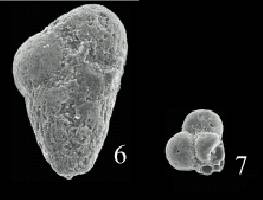
Heterohelix globulosa
(6); Guembelitria trifolia (7)
|
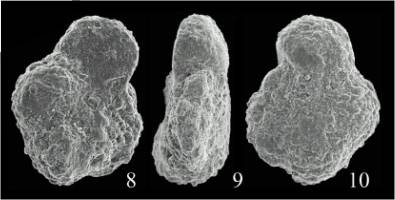
Rugoglobugerina scotti |
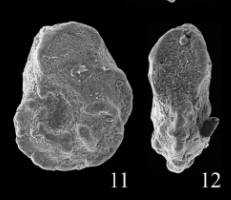
Planomalina buxtorfi
|
|
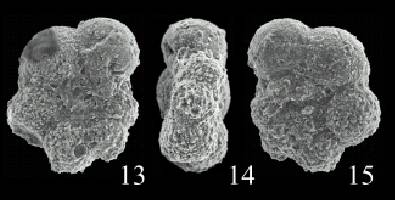
Hedbergella planispira
|
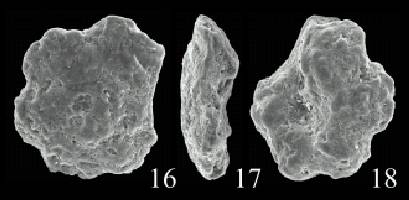
Praeglobotruncana
delrioensis
|
8-10:
794.31 m
7, 16-18: 794.33 m
13-15: 794.37
m
6, 11-12: 794.44 m
|
Argumentation
"Higher up in the K/P cocktail
unit, and overlaying the redeposited suevite,
there is a 46 cm-thick dolomitic calcareous
sandstone unit with common amalgamated dolomite
crystals. We studied 13 samples from this
unit (794.60 m to 794.14 m), where three
subunits can be recognized. The lower subunit
consists of a 24 cm-thick (794.60 m-794.36
m) crossbedded body of very dolomitized,
calcareous sandstones with some microconglomerate
layers intercalated. The cross-lamination
and the microconglomeratic layers indicate
high current activity during its deposition.
The middle subunit consists of a 17 cm-thick
(794.36 m-794.19 m), predominantly laminated,
dolomitic calcareous sandstone layer. The
upper subunit consists of a 5 cm-thick (794.19
m-794.14 m) bioturbated, dolomitic calcareous
sandstone bed, the top of which represents
an omission surface. In spite of the fact
that we intensively scanned the sediment
in this interval, foraminifera are practically
absent in the 13 samples recovered from
the dolomitic calcareous sandstone unit,
though some reworked specimens were found.
The dolomitization processes affecting these
rocks might be one of the reasons for the
scarcity of foraminifera in this unit. A
3-4 cm-thick (794.14 m-794.11 m) laminated
marly clay layer with ichthyoliths overlies
the dolomitic calcareous sandstone unit.
Sample 794.11 m is barren of planktic foraminifera,
and it yields only few benthic specimens".
"In the 46 cm-thick dolomitic calcareous
sandstone unit overlaying the redeposited
suevite (794.60-794.14 m) at Yaxcopoil-1,
we found only 11 planktic foraminiferal
specimens that belong to the species
Guembelitria cretacea, G. trifolia,
Heterohelix globulosa, H. navarroensis,
Praeglobotruncana delrioensis, Hedbergella
planispira, Planomalina buxtorfi, Rugoglobigerina
scotti, and Globigerinelloides
volutus. They represent reworked, mixed
assemblages containing species from the
Albian-Turonian (P. delrioensis, H. planispira,
P. buxtorfi) and Campanian-Maastrichtian
(H. navarroensis, R. scotti)."
1.4
Ripostes by J. Smit et al. (Meteoritics
& Planetary Science 39, Nr 7, 2004)
"The core interval 794.60-794.11
m contains the critical transition from
the impact to post-impact
lithologies. The transition is visually
sharp and marked by a dark 2 cm-thick clay
layer at 794.11 m. It is tempting to equate
this level to the K/T boundary, but that
is not correct."
"The unit probably represents a hardground.
The rock is strongly indurated. Several
round, non-collapsed burrows filled with
dolomite, crystalline lithoclasts, or smectite
blebs can be observed. As all burrows in
the overlying sediment are strongly compressed
due to compaction. Reworked bioclasts containing
indeterminate foraminifers increase upward.
The top 2 cm grades into a dark clay at
794.11-794.10 m. This interval displays
an increasing number of horsetail laminations."
"But, is the Yax-1 section really complete?
Several lines of evidence indicate that
it is not. Therefore, the Yax-1 drill core
cannot be used to test the above mentioned
hypotheses. The crossbedded interval from
794.60-794.19 cm contains several levels
(at 794.52 and 794.40 m) where overlying
crossbedded sediments onlap on a previously
lithified surface. This suggests a hiatus
at these levels."
"Several burrows are round and non-compressed,
suggesting that they were made by lithofagous
borers after lithification and remained
open when they were filled by clay and fragments
of green clay blebs and dolomite clasts.
The overlying 2 cm-thick clay layer seems
to be a residual clay, left after dissolution
of carbonate. The typical horsetail laminae,
similar to stylolites, suggest strong dissolution,
and the abundance of fish remains also suggests
the presence of an omission surface that
is often enriched in residual fish debris.
The clay layer itself, if comparable to
the global K/T boundary clay, would be enriched
in siderophile elements and might contain
microkrystites."
"These lines of evidence suggest that the
clay is a residual clay, overlying a hardground
surface, both indicative of a significant
hiatus rather than being the equivalent
of the K/T boundary clay. The magnitude
of the hiatus is difficult to assess. The
foraminifers in the first post-impact
background infill are strongly dissolved,
and the interval may be condensed."
"Since part of the top of the ejecta sequence
in Yax-1 is eroded, and a hiatus of up to
330 kyr is present at the top of the ejecta,
the hypothesis Stinnesbeck et al. (2001)
cannot be accepted or rejected on the basis
of Yax-1 data. The suggestion by Keller
et al. (2004) that the crossbedded interval
794.6-794.11 contains an indigenous Cretaceous
planktic fauna is highly unlikely for several
reasons:
1) we did not find Cretaceous taxa but found zoned dolomite rhombs instead.
Arz et al. (2004) found just a few badly
preserved specimens in samples from the
same levels. The size of the rhombs and
the thickness of the zonal overgrowth of
the dolomite rhombs is comparable to the
thickness of a foraminiferal shell, creating
the illusion of foraminiferal shells when
two adjacent dolomite rhombs are positioned
together.
2) even if Cretaceous taxa are present, their presence within crossbedded
sandstone layers suggests that they are
reworked from older units, and therefore,
they cannot be used for a biostratigraphic
age."
1.5
My opinion to the debate
PEMEX investigators of the l970’s (Meyerhoff
et al and Lopez-Ramos) reported limestones
with diverse planktic foraminiferal assemblages
of upper Maastrichtian age overlying
the breccia in wells Chicxulub-1 and Yucatan-6.
An interval of 18 m-thick Maastrichtian
marls overlying the "impact" breccia at
the C-1 well. It was identified the planktic
foraminiferal species Globotruncana rosetta,
G. ventricosa, G. lapparenti, G. fornicata,
Pseudoguembelina excolata, Heterohelix globocarinata,
Pseudotextularia elegans, Planoglobulina
carseyae, and Globigerinelloides
volutus in this interval and conclude
that the Chicxulub event occurred before
the K/T-boundary.
By Keller et al (2004) in Yaxcopoil-1,
unit 794.60-794.11m, detected Maastrichtian
foraminifera are unfortunately dolomitic
crystallized and give rise to discussion.
Smit interpret these forms as dolomite
rhombs.
Nevertheless, the conclusions of Keller
et al. are right, and the Chicxulub event
has nothing to do with the K/T-boundary.
The K/T-boundary is biostratigraphically
in profile clearly placed 0.50 cm above
the breccias. The discussed sediments in
the unit above the breccia are no catastrophic
or hardground deposits (in sense Smit),
they in contrary are layered in a normal
marine milieu with moderatly movements during
a longer period of time (300 000 years ?).
After the event the devastated land surface,
after a time gap, was flooded again by a
marine transgression. The first marine deposits
consists of fine material (volcanic mud?)
that may have been transported mostly fluviatile.
A portion of the sediments shows millimeter
fine laminations. This indicates slightly
increased water-energy for the deposition
on ground. Moreover, in the sediments was
bioturbation detected. Striking are inserted
thin layers of green clay (or glauconite)
indicate altered sedimentation conditions.
The last "green clay" layer (794.12m) is
markedly and could be the equivalent of
the "Boundary Tone". The bubble-like inclusions
in the greenish layer could be former spherules
from the widespread volcanism after the
Chicxulub event.
The
conclusions by Arz et al. (2004)
for the Yaxcopoil-1 unit 794.60-794.11m
are not right. They confirmed unintentionally
the thesis of Keller el al., because the
detected Cretaceous foraminifera are
not reworked. They are in good condition.
A reworking during the postulated catastrophic
crater infilling (where are breccias) would
have destroyed these filigree casings. Furthermore,
how it should be possible these originally
in the limestone embedded casing undamaged
to isolate after a short time. The postulated
mixed reworking assemblage of foraminifers
(Albian-Turonian and Campanian-Maastrichtian)
should be evaluated with caution. There
are also long-lived Cretaceous species therein.
|




































